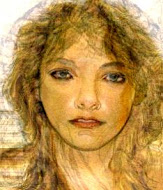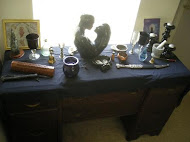Litha Correspondences / Associations
from The Sacred Grove
Date: June 20-23 (varies according to the position of the Sun).
Names: Summer Solstice; Midsummer; Litha (Wiccan); Alban Hefin (Druidic); nti Raymi (Incan); Feast of the Sun (Aztec); Celtic New Year, according to some; St. John's Day/Festival of Saint John the Baptist (Christian).
Sacred To:
- Gods: Horned Gods; Oak Kings; Sun Gods; Baldur; Mars; Nergal
- Goddesses: the Midsummer Bride, the lion-guarded Queen of the Year; Aine of Knockaine; Kupala; Mother Nature; Aphrodite Erycina, Aphrodite of the Heather, the nymph-goddess of Midsummer; Astarte/Anatha, the Love and Death, Goddess of Midsummer; Vesta, for whom fires were lit at Midsummer.
Foods: fresh vegetables, summer fruits, pumpernickel bread, ale and mead.
Incense: frankincense, lemon, myrrh, pine, rose and wisteria.
Candles: blue, green, gold, red, yellow, bright colors, pastels.
Gemstones: all green stones (emerald and jade).
Celebrating: abundance, fertility, virility, the beauty and bounty of Nature. It is a good time for empowerment, for strong magic and male rituals, for handfastings and communing with Nature Spirits, for workings of consummation or culmination. The door to the Faery Realm is said to open on Midsummer Night, and twilight to be the best time for faery magic. Celebrate Mid-Summer with fire and singing and feasting, with all-night vigils and torch lit processions. Weave green boughs and crowns of flowers. Dance around a bonfire. Decorate your altar with candles and flowers. Perform the Great Rite in the fields. Erect a Midsummer Tree. Set a fire wheel ablaze (being mindful of fire safety, of course). Walk naked or ride a broomstick through fields as a fertility charm. Draw down the Sun. Drink mead or use it for offerings. Make honey cakes or cornbread with honey butter for the feast.
Tools: wand, athame, sword, spear, staff ... all the phallic ones.
Plants: all flowers, roses, heather, oak, St. John's Wort, MugWort, St. John's Flower. St. John's Wort symbolizes the Wiccan festival of Summer Solstice. A plant was hung up in the house for each member of the family. The remaining plants were bundled, tied to a pole, and set up where grain would be brought at the next harvest. Farmers prayed to the goddess Kupole for a good harvest. The bundle of herbs, called the Kupole, represented her. Heather is the Midsummer Tree of the Summer Solstice. Aphrodite Erycina, Aphrodite of the Heather, mated with the sacred king atop a mountain then killed him by tearing out his genitals. St. John's Flower/St. John's Blood/Mouse-eared Hawkweed (Hieracium pilsoella) was uprooted with gold coins on Midsummer Eve in Germany and Bohemia. Celts, Druids and Scandinavians gathered mistletoe at Midsummer. White elder flowers are sacred to the White Goddess at Midsummer. Orpane/Midsummer Men (Sempervivum telephium, a variety of houseleek) was gathered on Midsummer Eve along with sprigs of red sage and used to divine the fate of lovers.
Fire: Midsummer fire was considered the fire of heaven.
Bonfires:: Bonfires are kindled for health, fertility, love, sacrifice or purification. There is a long European tradition of lighting bonfires at Midsummer, especially of oak wood and in high places. Twin bonfires were common. Smoke of the green oak, burned on Midsummer Eve fires, is painful and gives inspiration to those who dance between the twin sacrificial fires. In some places a Midsummer Tree was used to kindle the bonfire.
Health: The Midsummer bonfire was thought to drive away the dragon that causes disease.
Fertility: The ashes of the bonfire were scattered as a fertility charm. Moroccans and Algerians threw incense and spices on their Midsummer bonfires all night, invoking divine blessings on the fruit trees. In parts of England the Midsummer fires were lit in the fields to bless the apples. Midsummer bonfires were jumped over to make flax grow as high as the people could jump. In some parts of Germany young people jumped over Midsummer bonfires to make the flax or hemp grow tall.
Sacrifice: Basques burned vipers in wickerwork panniers on Midsummer Day. Firewheels: Firewheels symbolize the sun at its highest point. They were usually rolled down a hill into water, simulating the course of the sun. Midsummer Charms: The charred embers from a Midsummer bonfire are potent magic, charms against injury and bad weather. They are placed in fields or around trees for agricultural fertility, placed in meadows and atop houses to protect them. People in some parts of France held branches of nut trees when they jumped the Midsummer bonfire. These branches were then hung over the doors of cattle stalls. On the Isle of Man blazing gorse was carried several times around folded cattle on Midsummer Eve. St. John's Wort, gathered on Midsummer Eve, is worn as an amulet or hung up over doors or windows as a charm. Gathered naked that night, it is used for fertility. Mugwort has magical powers when gathered on Midsummer Eve. A Mugwort garland woven at Midsummer, worn as a crown or used for viewing the bonfire through, was a charm to ensure that you would have no headaches or eye pain that year. Mugwort was sometimes thrown on the Midsummer bonfire. The French wove garlands of it at Midsummer for protection against ghosts, magic, bad luck and disease for that year. In Bohemia, fir cones gathered before sunrise on Midsummer Day were believed to confer invulnerability. Wild thyme collected on Midsummer Day in Bohemia was used to fumigate trees as Solstice as a fertility charm, to make them grow well. Fennel was hung on doors on Midsummer Eve in medieval times to ward off evil spirits. Ferns generally reproduce via spores, but it was believed that fern seed was magical at Midsummer. Gathered on Midsummer Eve by spreading a white cloth below it, so as not to touch it with the hands, fern seed was believed to confer invisibility and the ability to understand the language of animals. Bohemians believed that fern seed bloomed with fiery golden blossoms on Midsummer Eve, and that the person who climbed a mountain holding it would find a vein of gold and see the treasures of the earth shining with a bluish light. Oil of St. John was a decoction of mistletoe that had been gathered on Midsummer Eve. It was believed to heal all wounds made with cutting instruments. In Sweden the Midsummer mistletoe was attached to the ceiling of the house, horse stall or manger to render the Troll powerless to inflict harm on people or animals. In Italy young singles gathered around a standing stone at Midsummer, the boys wearing green ears of grain and the girls wearing flax flowers, to leave plants on the stone. The affections of a couple were believed to last as long as the plants stayed fresh upon the dolmen.
Divination: Nettles were planted or put into water on Midsummer Eve in Sicily. The way they were found on Midsummer Day, blooming or fading, was an omen, especially as to fortune in love. In Moselle, France a good vintage was expected if the Midsummer Eve fire wheel was still aflame when it rolled into the river. In Italy wheat and barley were sown in small pots a few days before Midsummer. Each pot represented a specific person. Fortune and good luck were believed to come to those whose grain had sprouted well by Midsummer Day, bad luck to those whose grain had not.
Midsummer Trees: Maj Stanger, Swedish Midsummer trees, were made from tall, straight spruces with their branches stripped off. Wood was sometimes attached so that the trees represented a man with his hands on his hips. The Midsummer tree was decorated by village maidens with leaves, flowers, strips of cloth and gilt eggshells. A large vane or flag was placed on top. Bohemian Midsummer trees were made of fir or pine and decorated by girls with flowers, garlands and red ribbons. The bonfire was kindled of the tree that night, the garlands tossed back and forth across the blaze by boys and girls. Couples held hands and jumped over the embers three times. Singed garlands were saved to burn in the hearth during thunderstorms, or fed to sick or calving cows.
Death of The Sacred King: We have evolved and no longer practice blood sacrifice of any sort, but the ritual murder of the sacred king was once a solemn European vegetation rite of Midsummer. He was not a king as we understand that term in modern times but rather the embodiment of male virility, a Hercules figure. He was crowned with roses and wreathed with myrtle, enjoyed the favors of the queen/priestess, but Midsummer was when he felt the stab of the thorns and his rule came to an end. The sacred king's sacrificial death ensured the fertility of the crops and the survival of the tribe. The ekingi was symbolically beheaded as a part of the Bohemian Midsummer vegetation ceremonies. He wore a tree bark robe decorated with flowers, a bark crown bedecked with branches and flowers, a mask, and had ferns on his feet. He carried a hawthorn switch for a scepter and was accompanied by young people wearing bark girdles who carried wooden swords and willow bark trumpets. There was a chase through the village followed by a mock trial. If the king was found guilty, several hats would be placed atop his head so that they could be chopped off when he knelt down.
Global Rites:
- Incan: Inti Raymi, the Feast of the Sun, marked Winter Solstice in the southern hemisphere. To celebrate make libations of chicha (maize beer). Make offerings to the Sun. Kindle new fire from the sun, with a mirror.
- Egyptian: In some parts of ancient Egypt the somber rites of the presentation of the first sheaf of harvest wheat to Min took place at Midsummer.
- Phoenician: Dirges were sung for the child Linus at Midsummer during the flax harvest.
- Native American: Sun Dances
- German: Latzman, the Lazy Man of Midsummer Day festivities, was a conical or pyramidal wickerwork frame covered with fir sprigs.
- Irish: Torches made of bundled reeds were carried on Midsummer Eve.
- Serbian: Birch bark torches were lit on Midsummer Eve and carried around the sheepfolds and cattle stalls. The people then climbed up into the hills, where the torches were allowed to go out.
- Austrian/Bavarian: Boys decked out in green fir branches went from house to house with a group of young people to collect wood for the Midsummer bonfire.
Fair Use Notice: This page may contain copyrighted material the use of which has not been specifically authorized by the copyright owner. This website distributes this material without profit to those who have expressed a prior interest in receiving the included information for research and educational purposes. We believe this constitutes a fair use of any such copyrighted material as provided for in 17 U.S.C § 107.
Disclaimer: No one involved in this blog or its contents may be held responsible for any adverse reactions arising from following any of the instructions/recipes on this list. It is the reader’s personal responsibility to exercise all precautions and use his or her own discretion if following any instructions or advice from this blog.















No comments:
Post a Comment